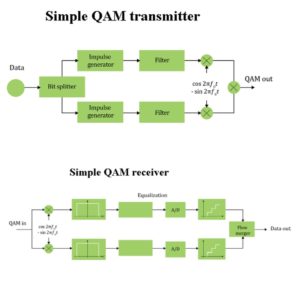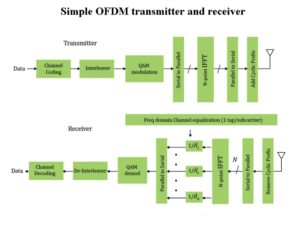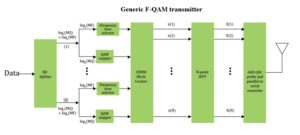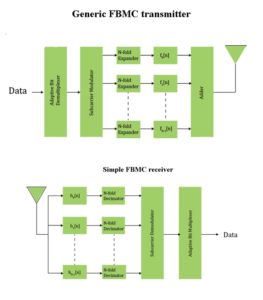The IoT will make heavy use of fifth-generation mobile networks that use a yet-to-be-determined modulation scheme. Here are the major contenders.
LEE TESCHLER | EXECUTIVE EDITOR
Fifth-generation mobile networks, abbreviated 5G, will form the telecommunications standards for the internet of things. Planners say 5G will have a higher capacity than the current 4G equipment partly to support the device-to-device, ultra reliable, and massive machine communications expected to help define the IoT of the future. Among the goals of 5G: lower latency than 4G equipment and lower battery consumption, data rates of tens of megabits per second for tens of thousands of users, several hundreds of thousands of simultaneous connections available for wireless sensors, along with better spectral signaling efficiency.
The better spectral efficiency will partly be a function of the modulation schemes used in 5G. However, those modulation schemes have yet to be standardized. There are several contenders, and derivatives of the same quadrature-style schemes in use by mobile networks today haven’t been ruled out for 5G. So it is interesting to review the major modulation techniques now up for consideration as part of 5G.
Techniques discussed for 5G tend to use multiple carriers as a means of obtaining spectral efficiency. At present 4G LTE uses QAM (quadrature amplitude modulation) with OFDM (orthogonal frequency division multiplexing) as modulation and OFDMA (OFDM multiple access) as access scheme. 5G will provide a high bit rate so it will need to make efficient use of the spectrum. Several of the ideas proposed for 5G are hybrids of QAM and OFDM principles.

First a few basics. Quadrature techniques represent a transmitted symbol as a complex number and modulate a cosine and sine carrier signal with the real and imaginary parts. This lets the symbol be sent with two carriers. The two carriers are generally referred to as quadrature carriers. A coherent detector can independently demodulate these carriers. This principle of using two independently modulated carriers is the foundation of quadrature modulation.
QAM conveys information by modulating the amplitudes of the two carrier waves, using either amplitude-shift keying (ASK) for digital data or straight amplitude modulation for analog. The two carrier waves of the same frequency, usually sinusoids, are out of phase with each other by 90°. The modulated waves are summed, and the final waveform is a combination of both phase-shift keying (PSK) and amplitude-shift keying (ASK).
QAM is said to be spectrally efficient, and the reason becomes clear by comparing a QAM signal with that of an ordinary AM’ed carrier. A straight amplitude-modulated signal has two sidebands. The carrier plus the sidebands occupy twice the bandwidth of the modulating signal. In contrast, QAM places two independent double-sideband suppressed-carrier signals in the same spectrum as one ordinary double-sideband suppressed-carrier signal.
QAM can give arbitrarily high spectral efficiencies by setting a suitable constellation size. As a quick review, a constellation diagram represents the signal as a scatter diagram in the Q and I axes and represents the possible symbols as points on the plane. The more symbols defined in the modulation scheme, the more points on the constellation diagram. The number of points at which the signal can rest, i.e. the number of symbols, is indicated in the modulation format description: 16QAM uses a 16-point constellation, and so forth.
Constellation points are normally arranged in a square grid with equal vertical and horizontal spacing. Use of higher-order modulation formats, i.e. more points on the constellation, makes it possible to transmit more bits per symbol. However, use of higher-order symbols positions constellation points closer together, making the link more susceptible to noise. Specifically, it takes less noise to move the signal to a different decision point on the constellation diagram.
A point to note about QAM is that it is considered a single-carrier system. The two digital bit streams come from one source that is split into two independent signals.
QAM signals are often sent via multi-carrier modulation schemes that transmit one QAM signal over one of several subcarriers. The point of doing this is to simplify the task of compensating for distortions arising in the communication channel. Each of the subcarriers has a small bandwidth. The communication channel has a relatively flat frequency response over each of these small bands. So it is relatively easy to compensate for distortions over each of the small subcarrier bands.
In OFDM, many closely spaced orthogonal sub-carriers carry data on several parallel data streams or channels. Each sub-carrier is modulated with a conventional modulation scheme such as QAM at a low symbol rate, maintaining total data rates similar to conventional single-carrier modulation schemes in the same bandwidth.

The primary advantage of OFDM over using a single carrier is its ability to cope with severe interference as caused by RF sources at nearly the same frequency or frequency-selective fading from multipath. OFDM may be viewed as using many slowly modulated narrowband signals rather than one rapidly modulated wideband signal. The low symbol rate makes the use of a guard interval between symbols affordable, making it possible to eliminate intersymbol interference (ISI) and use echoes and time-spreading to improve signal-to-noise.
The orthogonality of OFDM comes from the selection of the sub-carrier frequencies so they are orthogonal to each other. This basically means the spectrum space between sub-carriers obeys a mathematical relationship where it is inversely proportional to the symbol duration. Sub-carriers spaced this way don’t experience any cross-talk and thus eliminate the need for inter-carrier guard bands, simplifying the design of both the transmitter and the receiver.
There are a few inherent difficulties with OFDM. One is that an OFDM signal can have a high instantaneous peak compared to its average level. There can also be a large signal amplitude swing when the signal traverses from a low to a high instantaneous power. The power amp used must be linear over a wide bandwidth to prevent a high out-of-band harmonic distortion. This phenomenon can potentially interfere with adjacent channels.
Other difficulties arise with the time and frequency synchronization between the OFDM transmitter and receiver. Numerous techniques have been proposed for estimating and correcting both timing and carrier frequency offsets at the OFDM receiver. For example, one idea is to embed pilot tones into OFDM symbols, then use timing and frequency acquisition algorithms to sync on them.
HYBRID SCHEMES FOR 5G
Several of the modulation schemes under review for 5G are hybrids employing elements found in QAM and OFDM. One is called F-QAM or FSK-QAM. F-QAM is a combination of QAM and frequency shift keying (FSK). It has been proposed in conjunction with OFDMA, the multi-user version of OFDM where individual users are assigned subsets of subcarriers.

F-QAM combines MF-FSK (multiple frequency FSK) and MQ-QAM (multiple QAM modulation levels). F-QAM has many similarities with OFDM-IM (OFDM with index modulation). In both cases the information is not only conveyed through the modulated symbols but also via the indices of the active subcarriers. At the receiver side, the detection process is similar to that of the OFDM-IM. The receiver employs what’s called a log-likelihood-ratio (LLR) detector to determine the active subcarrier in each sub-block and, afterwards, estimates the received symbols using a maximum likelihood (ML) detector.
One drawback of current OFDMA schemes is that they require accurate synchronization of the user signals at the base station. Such synchronization is not straightforward and demands a lot of resources. So a lot of the work on 5G aims at a way around this base station syncing. One idea from AlcatelLucent Bell Labs is a modified OFDM waveform dubbed universal filtered multicarrier (UFMC). UFMC passes each bundle of adjacent subcarriers that belong to a user through a filter to minimize multi-user interference. Bandwidth efficiency is kept at the same level as OFDM, but UFMC uses no cyclic prefix (CP). The interval the CP normally occupies instead absorbs the transient of the underlying filters, making the filtering more effective.
Generalized frequency division multiplexing (GFDM) is another candidate waveform. GFDM may be thought of as a modified OFDM, where each subcarrier is shaped by a high-quality filter. To allow the addition of the CP, the subcarrier filtering operation in GFDM is based on a circular convolution.
 Another 5G contender is based on filter bank multicarrier with offset QAM (FBMC-OQAM). FBMCs employ two sets of bandpass filters called analysis and synthesis filters, one at the transmitter and the other at the receiver, to filter the collection of subcarriers being transmitted simultaneously in parallel frequencies. FBMC filter bandwidth, and therefore selectivity, is a parameter that can be varied during design. FBMC also offers better bandwidth efficiency when compared to OFDM. FBMC eliminates the need for CP processing while efficiently attenuating interferences within and close to the frequency band. FBMC systems are also comparatively more resistant to narrowband noise.
Another 5G contender is based on filter bank multicarrier with offset QAM (FBMC-OQAM). FBMCs employ two sets of bandpass filters called analysis and synthesis filters, one at the transmitter and the other at the receiver, to filter the collection of subcarriers being transmitted simultaneously in parallel frequencies. FBMC filter bandwidth, and therefore selectivity, is a parameter that can be varied during design. FBMC also offers better bandwidth efficiency when compared to OFDM. FBMC eliminates the need for CP processing while efficiently attenuating interferences within and close to the frequency band. FBMC systems are also comparatively more resistant to narrowband noise.
OTHER IDEAS
Though multi-carrier systems seem to be getting most of the attention for 5G, experts say single-carrier modulation could still be part of the spec. There are also what might be termed odd-ball techniques still in the mix. One is called faster than Nyquist (FTN) modulation. It is a non-orthogonal subcarrier system that actually makes use of intersymbol interference to pack more data into a communication channel.
Another non-orthogonal idea is called time-frequency packing. The carriers are close together, and a super-sophisticated detector in the receiver decodes the closely packed signals. TFS is implemented either with QAM or OQAM.
Finally, a couple of ideas from independent companies have been floated as 5G specs. One is called wave modulation (WAM) which comes from MagnaCom, an Israeli startup acquired by Broadcom. Here a set of algorithms implement a form of spectral compression. Details about WAM are sparse, but the spectral compression is said to enable a higher signaling rate thereby affording the use of lower-order symbol alphabet, which reduces complexity. It is also said to give an overall 10% system gain advantage, up to 4x increase in range, a 50% spectrum savings, improved noise tolerance, and increase in data speed.
Another company called Cohere Technologies patented a modulation technology called Orthogonal Time Frequency and Space (OTFS). Again, details about OTFS are sparse, but press releases put out by Cohere speak highly of it.
RESOURCES
QAM
F-QAM
OFDM

Leave a Reply